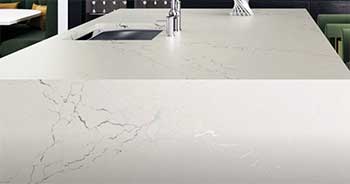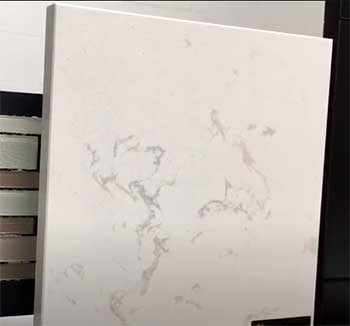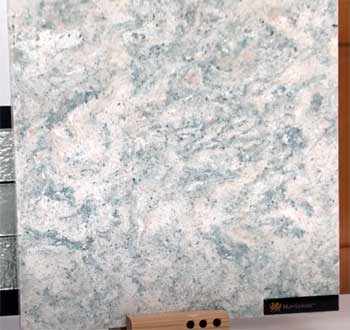Cambria quartz has become an increasingly popular option for kitchen and bathroom countertops in recent years. Made from natural quartz and resin, Cambria is marketed as a high-end, durable, and low-maintenance surface.
However, as with any product, Cambria quartz has received its fair share of complaints from homeowners over the years. In this article, we’ll take an in-depth look at some of the most common issues and problems that have been reported with Cambria quartz countertops.
Common Issues With Cambria Quartz
Here is a list of those problems:
- Staining and Discoloration
- Chips and Cracks
- Lack of Heat Resistance
- Seam Visibility
- Scratching and Marks
- Color Variation
- Fit and Finish Issues
- Delamination Issues
- Crackling Issues
Let’s talk about them in detail.
Staining and Discoloration
One of the biggest complaints about Cambria quartz is that it can become stained or discolored over time. While Cambria is marketed as stain-resistant, it is not completely stain-proof. Here are some of the staining and discoloration issues homeowners have reported:

- Dark spots forming from spices, marinades, juices, wines, and other liquids that have sat on the surface for too long
- Rings or cloudy marks left from hot pans or pots
- Difficulty removing dried-on food residue that leaves a stain if not cleaned quickly
- Discoloration and blotchiness from harsh cleaners and chemicals
- Spotting from hard water deposits over time
- Changes in color when exposed to direct sunlight for prolonged periods
The good news is that many stains can be removed from Cambria if treated quickly using a stain remover made specifically for quartz. But dark spots and etched marks can be permanent if not dealt with promptly. Preventing stains in the first place requires diligent cleaning and avoiding extended exposure to staining agents.
Chips and Cracks
Another common complaint from Cambria owners is chipping along the edges and cracks in the surface. Tiny chips and cracks can gradually form over time from:
- Bumping, chopping, or scraping against the sharp corner edges
- Dropping heavy objects on the surface
- Not using a cutting board for food prep
- Settling or movement in the cabinetry underneath
- Great temperature fluctuations causing expansion and contraction
Larger chips and cracks are usually the result of a significant impact. But small chips and hairline cracks can develop through normal everyday use. While a good fabricator should smooth and polish the edges during installation, the corners and edges remain prone to chipping if bumped.
Lack of Heat Resistance
Although marketed as more heat-resistant than natural stone, Cambria quartz can still suffer damage from excessive direct heat. Customers have reported issues like:
- Scorching, discoloration, and bubbling from hot pans and appliances
- Cracking near stovetops or baking surfaces from high heat exposure
- Damage when using the surface as a trivet for hot dishes
Cambria is engineered to withstand temperatures up to 300°F. However, prolonged direct heat exposure above 150°F can still cause damage. It’s important to use trivets and hot pads when setting hot cookware on the surface.
Seam Visibility
Since Cambria slabs are only available in 55” widths, countertops wider than this will require seaming two pieces together. Some homeowners complain that the seams are more visible than expected and don’t match up evenly.
Factors like:
- Color variation between slabs
- Misalignment during installation
- Settlement or shrinkage after installation
Can cause the two halves to not match up perfectly. While experienced installers can minimize the seam visibility, some mismatching is inevitable. The seam may look more obvious over time as the two halves shift and settle independently.
Scratching and Marks
While Cambria is touted as being scratch-resistant, it can still become marked up over years of use. Everyday items like ceramics, silverware, pans, and appliances can leave light surface scratches. Other causes of scratching include:
- Dragging heavy items across the surface
- Forcefully scrubbing with abrasive cleaners or scouring pads
- Sand and grit underneath objects moved across the counter
The matte finish that Cambria is known for can also more readily show dust, grease, fingerprints, and watermarks that accumulate. These marks may bother homeowners who expect the surface to stay looking freshly installed.
Color Variation

Cambria is made to mimic the look of natural stone, which means variation in veining, pattern, and color between slabs.
While an experienced installer will try to match slabs, there is no guarantee of an exact color match, especially for more variegated designs.
Some customers are disappointed to find noticeable differences in hue or veining between their seamed countertop pieces.
There can also be variation between samples and the actual installed slabs.
Fit and Finish Issues
Some homeowners complain that their Cambria countertop shows unsightly flaws around the edges, seams, or backsplash. This can include:
- Rough, uneven edges that weren’t properly smoothed
- Visible gaps, overhangs, or misalignment with walls
- Backsplash not fitting tightly against the wall
- Seams that weren’t cut precisely
- Corners that weren’t formed correctly
Fit and finish errors typically stem from low quality fabrication or installation. Any imperfections along the edges, seams, or backsplash can detract from the high-end aesthetic Cambria is known for.
Warping
In some cases, Cambria slabs can warp or bend slightly after installation. Factors like:
- Uneven supporting cabinets or substructure
- Settlement of newly constructed homes
- Thermal expansion in poorly ventilated areas
Can cause the quartz surface to flex or warp subtly. A table-like warp across the length of a countertop or individual warped spots are possible. Unfortunately warping can be difficult or impossible to fix once installed.
Delamination Issues
Delamination is when the outer quartz layer separates from the polymer backing. Spots of delamination can look like blisters or bubbles on the surface and occur when the bonding has failed. Contributing factors include:
- Excessive direct heat
- Extensive water exposure near seams/edges
- Settlement putting bond under tension
- Trauma from an impact or gouge
Delaminated areas often need total replacement as they can worsen over time when exposed to spills and cleaning.
Crackling Issues

Some Cambria slabs have developed fine crackling in the surface, resembling spiderweb-like cracks radiating outwards.
The cause is still being investigated, but seems to stem from internal stresses between the quartz and resin.
Wide temperature swings may exacerbate crackling.
Unlike structural cracks and chips, these hairline crackles are largely a cosmetic issue.
However, they understandably upset customers expecting a flawless appearance. Preventing exposure to temperature extremes may help minimize risk.
Sadly, there are more issues L
- Pitting Issues
Tiny pits or craters dotting the surface have been reported with some Cambria slabs. These pinhole-like depressions are believed to originate from air bubbles trapped during manufacturing.
The pits are mainly a cosmetic distraction, though food and grime can collect inside them.
- Visible Veining Differences
Since Cambria aims to mimic natural stone, the quartz particles and resin create random veining patterns. Occasionally two adjacent slabs will have mismatched or noticeably different veining.
Customers expecting a seamless look are disappointed to have distinct veining patterns meet at the seam.
- Gloss Loss Over Time
Cambria’s matte finish can gradually turn duller and lose its sheen with regular use and cleaning over time. This is especially common in busy kitchen areas.
Some customers don’t realize the finish will need routine upkeep by reapplying surface sealers to maintain the gloss level.
Frequently Asked Questions (FAQ)
Here are answers to some frequently asked questions about problems and complaints with Cambria quartz:
Cambria is susceptible to chipping along the edges and seams if subjected to impact or excessive force. The corners and edges can chip if bumped frequently. Proper installation and avoiding hits can help minimize chipping.
Overall Cambria offers good quality and durability compared to other engineered quartz brands. However, some flaws and issues can occur due to manufacturing variability or improper installation. Expectations need to be realistic for any manufactured product mimicking a natural material.
It’s not recommended to put hot cookware directly on Cambria, as excessive direct heat over 150°F can damage the surface. Using trivets and hot pads is best to prevent discoloration or cracking from hot pans.
Cambria and Silestone are two premium quartz brands. Silestone offers greater flexural strength and stain resistance. Cambria provides more realistic natural stone aesthetics. Quality comes down to individual slab and proper fabrication/installation. Either provides a durable and attractive countertop when properly cared for.
Conclusion
Cambria quartz remains a leading choice for high-end countertops due to its stylish appearance, hardness, and durability. However, it can develop issues with staining, chipping, seam visibility, heat damage, and other flaws in some situations.
Being aware of the potential problems allows homeowners to take steps to prevent damage and have realistic expectations. When fabricated and installed correctly using quality slabs, Cambria offers a beautiful, low maintenance countertop surface that can provide many years of enjoyment.
But some maintenance and care is still required, as no manufactured product is flawless. Weighing the pros and cons allows homeowners to decide if Cambria quartz is the right choice for their needs and expectations.

I am considering quartz countertops in a kitchen and a small bathroom. My question is: is quartz strong enough to support a ¼-¾ under mount stainless sink with a disposal ? Bearing in mind that cast iron cookware is sometimes washed in the sink. And in the bath I anticipate a 24″ vanity with an under mount oblong porcelain sink with a deck mount faucet.
Hi Lynn,
We just had the new Macbeth by Cambria installed. We under mounted a Kohler cast iron sink that weighs 135 lbs. I cook with cast iron as well and Lodge ware and have had both in my new sink. Other than being careful not to drop or set a cast iron directly on the surface, it certainly can hold the weight. Being an extremely clean fanatic, I wipe ever crumb constantly off surfaces immediately and I have noticed 2 circles (shadows) that are impregnated into the surface from I believe are the suction cups used to carry my peninsula. I was told that can happen from abrasive particles being trapped under the suction cups. So whoever is installing …make sure they do not scratch with tools or equipment. Now we have an issue to deal with.